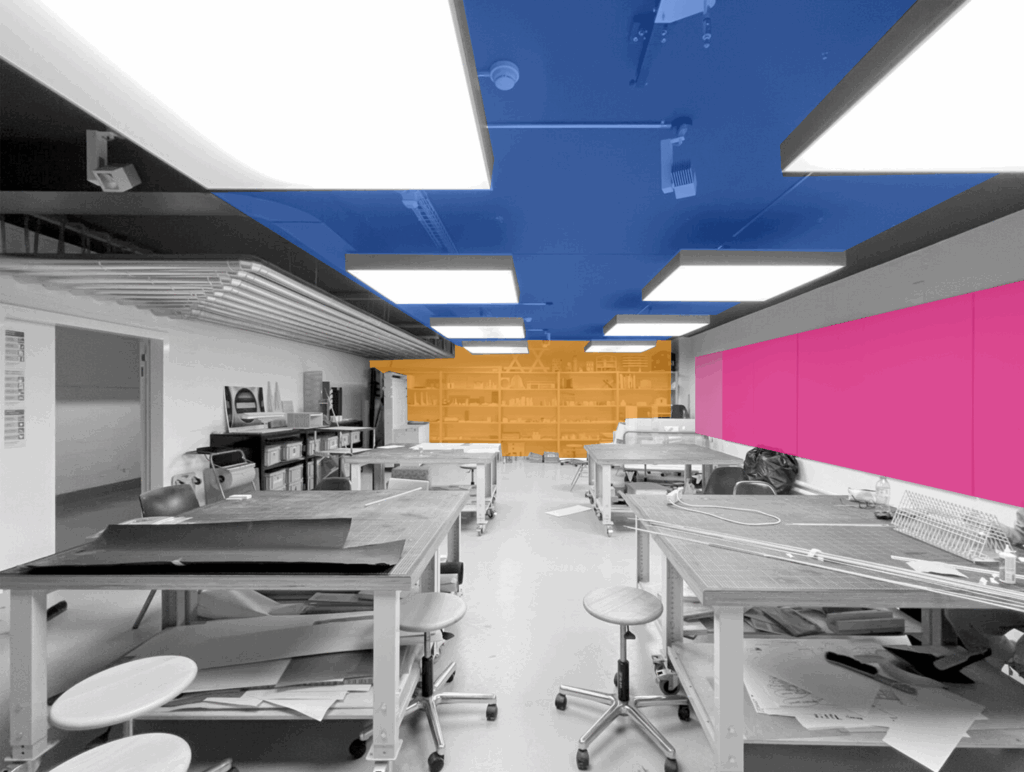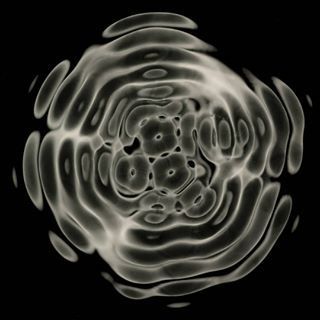1 Exploring Sound Qualities in Architectural Design
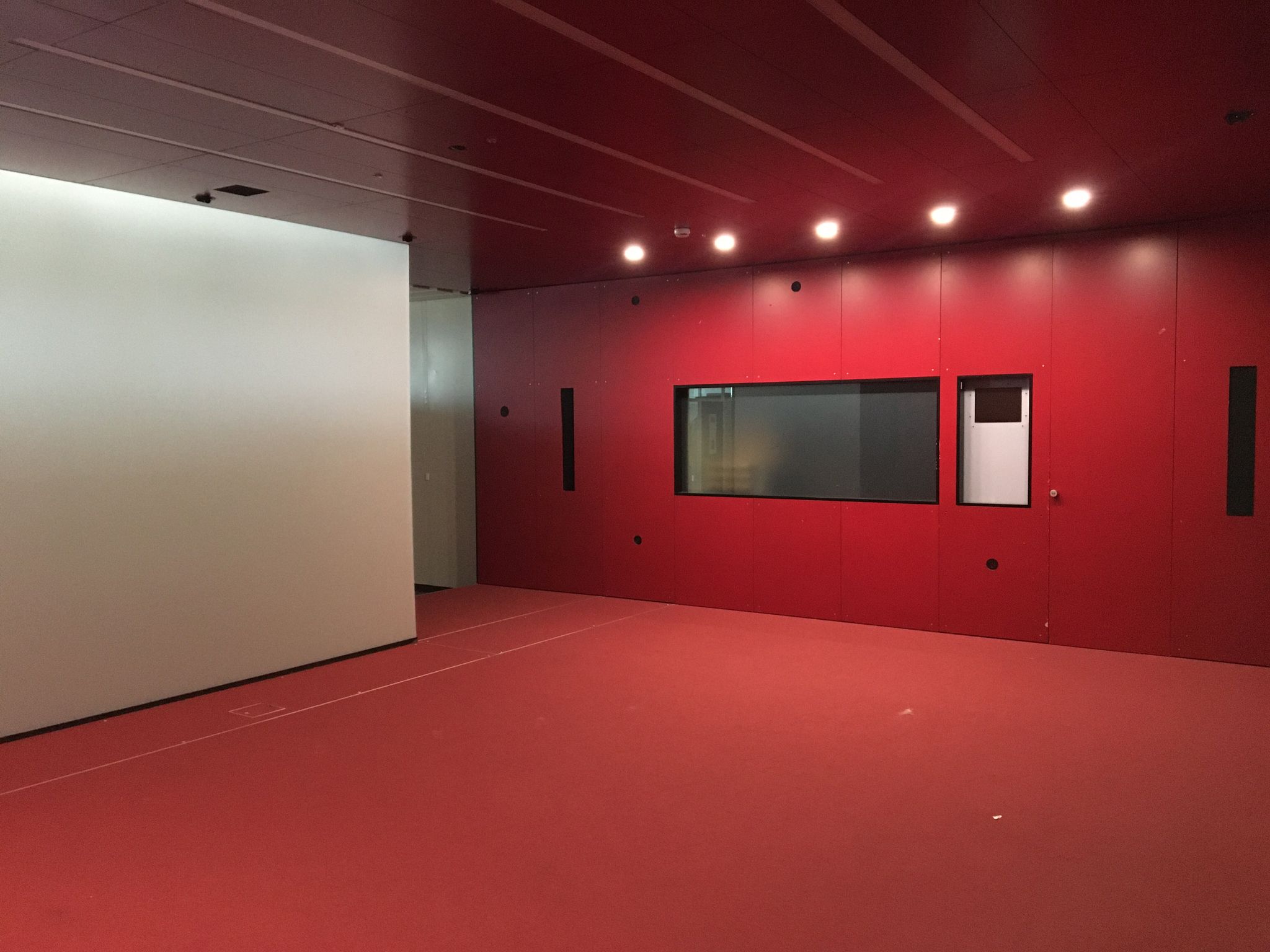
HIL E67 – The Red Hell
The first room I chose to look and listen into is the red room at HIL. It is technically only closed off on two sides and open towards two hallways on the other two. The hallways are very narrow and their ceilings are low, so they almost function as extensions of the room and therefore kind of close it off. I had thought that the two sides that are actually part of the room, as well as the floor and ceiling were covered in red felt that gives it a very interesting ambience visually and acoustically. Turns out that only the floor is covered in felt and that the ceiling and walls are made of some other, slightly reflective material.
The room is very quiet and dull and therefore an ideal place if you need to focus. However, there are never many people there, which adds to it being quiet and feeling heavy, but it also means that there is barely any noise at all. If there is someone and they are talking, the sound gets absorbed very quickly…That is what I wrote before visiting to do the recording and there were a lot of people [so I recorded a different time]. But I realized that, while it does absorb noise better than other places, the sound is not as crisp as I thought and there is more reverberation than there was in my mind.
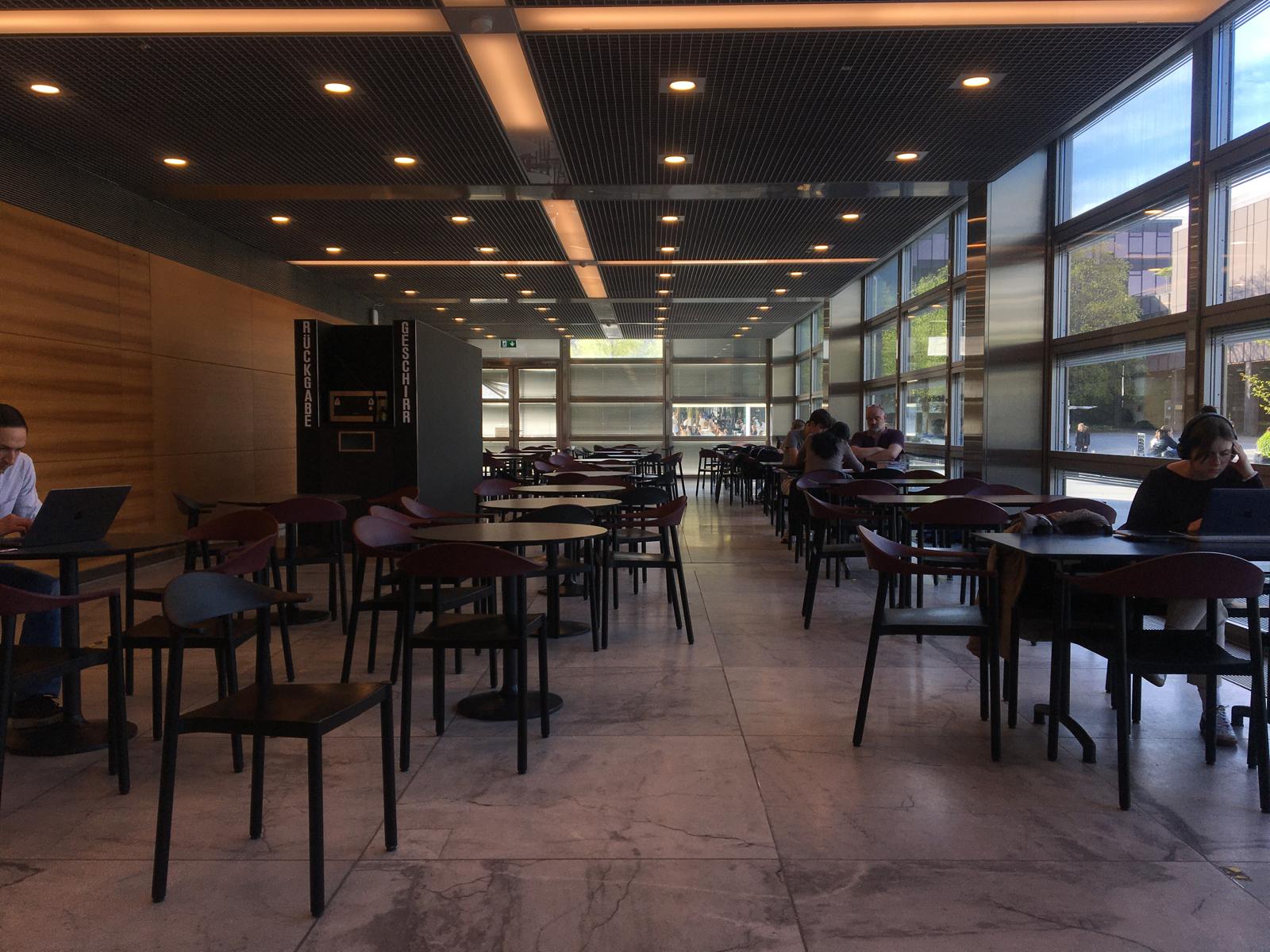
HCI Fusion
The second room that I analyzed acoustically is a hall in HCI, which has a lot of tables for people to eat at or to work. However, I have always felt like it had one of the worst acoustics profiles of any room on the campus. It should dull all the noises from people talking, eating, walking around and from all the plates and glasses clinking, but it does quite the opposite and even emphasizes them.
The room is surrounded by huge glass panels on three sides reaching from the floor all the way up to the ceiling, the wall on the fourth side is made from imitation wood and the floor of stone tiles. None of the wooden chairs that make up the interior have any kind of felt on the bottom to dull the scraping sounds they make when being moved around. Same with the tables; they don´t absorb any of the noise that is created when putting down plates and other items.
There is a lot of reverberation in the room; all the sounds are echoed and thus emphasized, creating a diffuse density of noise that is very unpleasant. It is very loud and therefore hardly convenient for chatting or studying.
While doing the recording, there were very few people in the room and I was not standing close to any of them. However, everything is clearly audible. It is also somewhat understandable, since there were not too many noises interrupting. But still, the few sources were already a lot, so it is definitely a lot more noisy and dense when there are more people.
2 Exploring the Emotional Impact of Everyday Sounds
Train during Rush Hour
One of the soundscapes I spend some time in almost everyday is the train I take to commute from my hometown to Zurich. I usually try to make the most of my time by working on the train, which is difficult at times since there is always an underlying sonic carpet disturbing my focus. Especially during rush hour when the train is crowded, the atmosphere is filled with a blend of human, mechanical and random sounds.
The train itself generates a variety of mechanical noises, some of which blend into the background while others stand out. The constant hum of the train´s movement is audible even with noise cancelling headphones – mine are not great though – and it intensifies in tunnels, where the sound waves reverberate much more than out in the open. The rumbling of wheels is particularly noticable when passing over switches since it causes an audible, but also tangible vibration. And although the former is somewhat loud and disturbing, the latter is not as much. Occasionally, there is another train rushing past whose whirring adds more density to the background noise. Probably the most disturbing mechanical sound comes from the brakes; their high-pitched friction almost hurts your eardrums, but it is worse when standing on the platform than being inside the train. There are also signals that probably get the second place when it comes to annoyance. Their harsh sounds cut through others and the announcements that follow are usually interrupting one´s train of thought.
The people on the train introduce another, probably more intrusive element to the soundscape. Their conversations range from soft whispers to loud, attention-grabbing exchanges that get more irritating the higher-pitched the voices are. This is also why screaming kids or babies are the peak of irritation on the train, which, luckily, there were none around when doing the analysis. But even if these piercing sounds are not existent, there is always someone breathing loudly, coughing or sniffling. The friction of clothes chafing against seats and bodies, although quiet, contributes to the more delicate textures of the soundscape.
Shortly before and after leaving a station, there are footsteps of people trying to find a seat and the shifting of bodies is an almost continuous sound. Once seated, they begin or continue with their activies and the sounds that adjoin those are very diverse. From the rustling of packaging, the sounds of drinks in bottles or the sharp clicks of cans opening to people chewing gum, there is always incidental noise that momentarily disrupts the atmosphere. Often, there is some – sorry to call it that, but – idiot playing videos on his phone without headphones and there is often also music leaking from headphones or typing sounds of laptops. Some of the noises are more expected and also softer in general, like pages of books and magazines turning or bags being (un-)zipped, but there are also others that I did not gauge would be there, like metal-on-metal contact of rings clinking against the handrails of the stairs.
The soundscape of a train is an interplay of auditory elements that is especially diverse and intense during rush hour. Low-frequency sounds, like the train’s movement, provide a constant backdrop that can be almost soothing when undisturbed. However, this is rarely the case and the sense of calm is usually broken by various noises that demand attention. And unfortunately, these sudden, irregular sounds tend to dominate; creating a sense of intrusion, particularly when experienced in close proximity. The volume and frequency of these disruptive sounds significantly contribute to a feeling of discomfort – the louder and higher-pitched they are – and the unpredictability of the interruptions introduces tension. Whereas softer sounds, like murmured concersations or the flipping of pages, tend to fade into the background.
Overall, the dense layering of sound oscillates between an underlying hum and sharp, disruptive elements, which leads to an environment that fluctuates between neutral and mildly stressful, often leaving one feeling overstimulated or fatigued.
Garden at Night
The place I find myself in when I need some quiet, is my garden. I chose to use it as my second psychoacoustic space to be analyzed and it so happened that it rained that evening. Being outside [in a somewhat natural environment] generally has a calming effect on me and that is partly because of the acoustics. More natural sounds and less man-made interruptions create less overstimulation than I experience in other spaces.
The rain itself formed the base layer of the soundscape that night with its rhythmic pattering of drops hitting various surfaces. Water directly falling from the sky create a soft, uneven percussion on the ground, wheaeas it creates slightly harsher, more noticable sounds when hitting objects. While hitting textile objects – like covers – produces a muted, dampened sound, metal surfaces – like pots – produces sharper and more resonant drips. When dripping from objects, there is usually a rhythmic pattern to it, making it more noticable..
Beyond the pleasant sounds of the rain, there are others that also are not as nice to listen to, but that tend to fade into the background. Driving cars can be heard and even more so when accelerating or driving through puddlles which creates splashing noises. Lower frequencies of truck engines can be deciphered from cars, but also from motorcycles, which create higher-pitched sounds that are the most disruptive out of the three. Since these noises usually fade into the background, I usually don´t differentiate between them, even if I could. Someone honked that evening and it was the most disturbing noise, but it was not as annoying as less disruptive noises on the train since I was generally less overstimulated. Shortly before going inside again, a plane flew over my head – or maybe it didn´t – since the noise was very boomy and diffuse.
Among all of the sounds created by traffic, there were also distant voices that got louder when coming closer and laughter that cut through the night but was not unpleasant to listen to. My own movement became more noticeable like the rustling of my fabric and a cough, but are somehow expected and integrated and therefore not as disruptive. Even the chime of church bells – that is annoying when eating dinner in the garden on a summer night – in this case feel like a deliberate and accepted part of the space. Their resonance lingers in the air and blends with the faint noises of the wind and rain. These gentle noises might be experienced as soothing even more at night since there are less stimulants in general.
3 Empirical and numerical estimation of room acoustic properties
*calculations done with OMNI calculator
Reverb calculation – The Red Hell
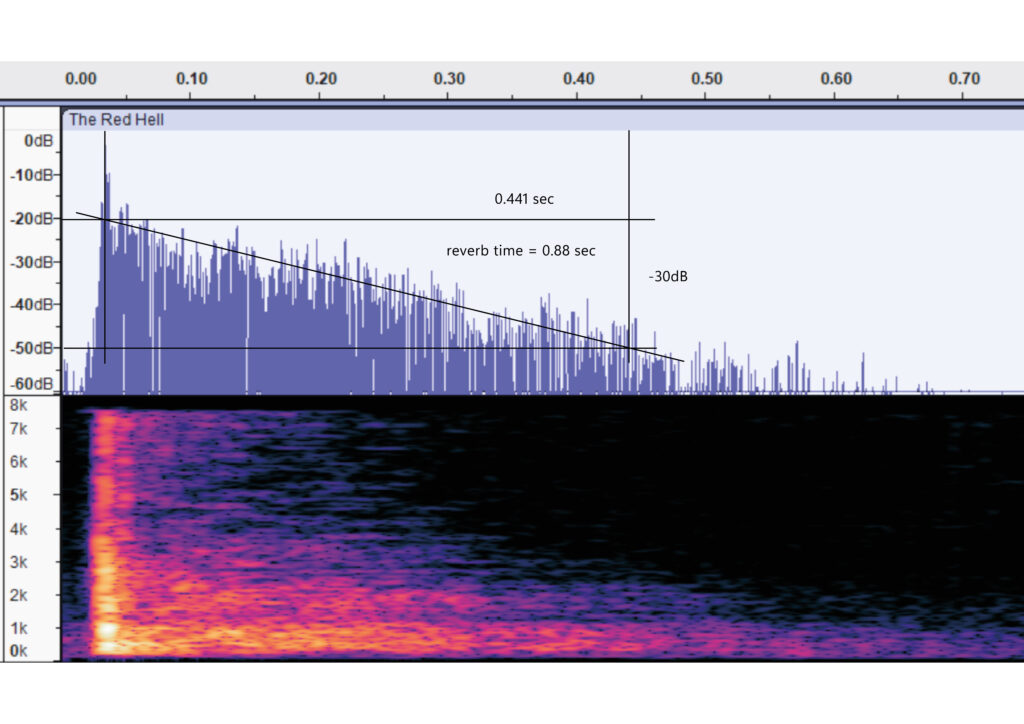
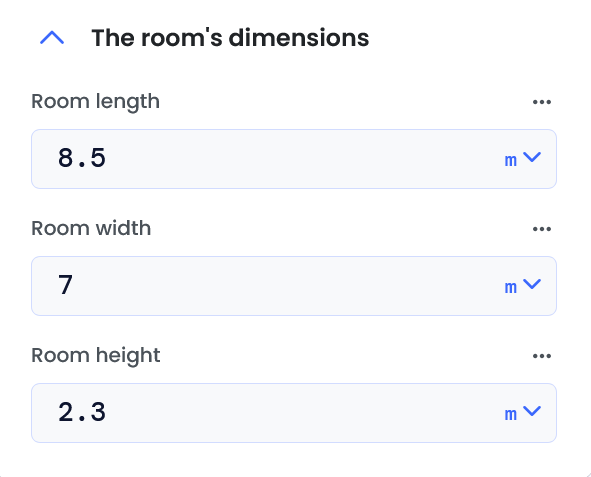
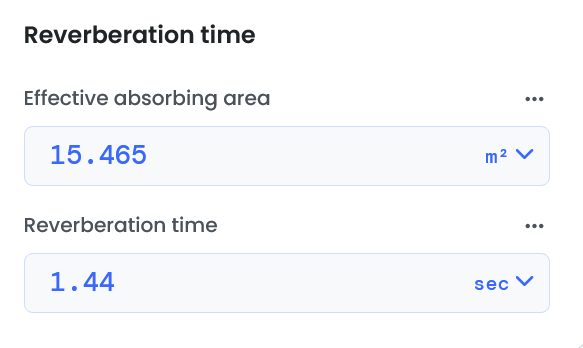
Reverb calculation – My Room
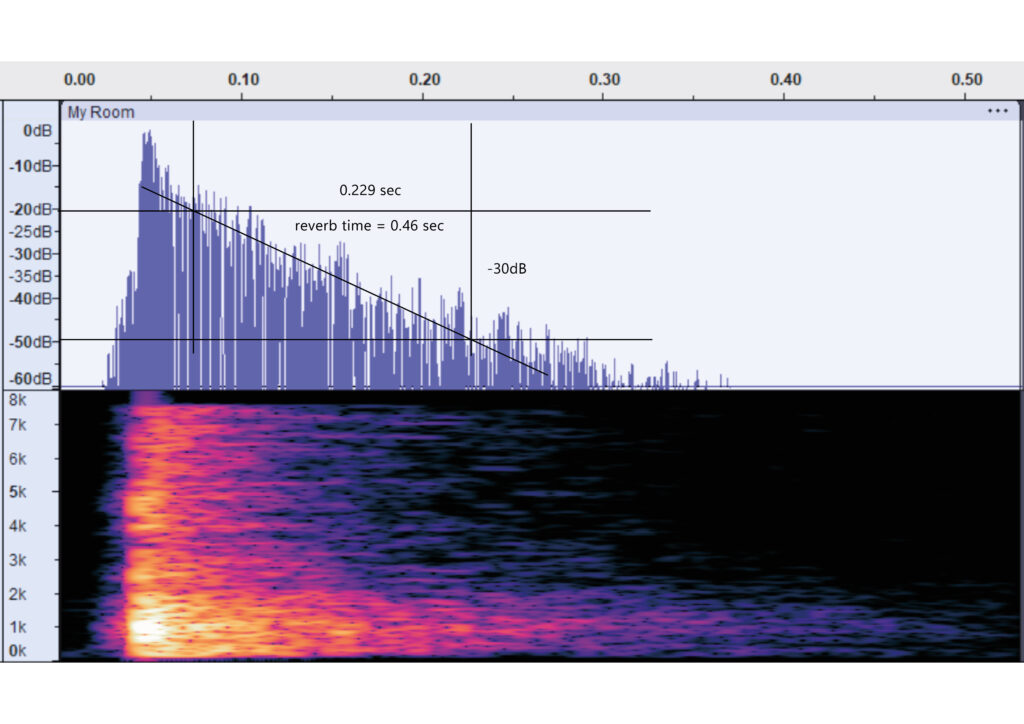
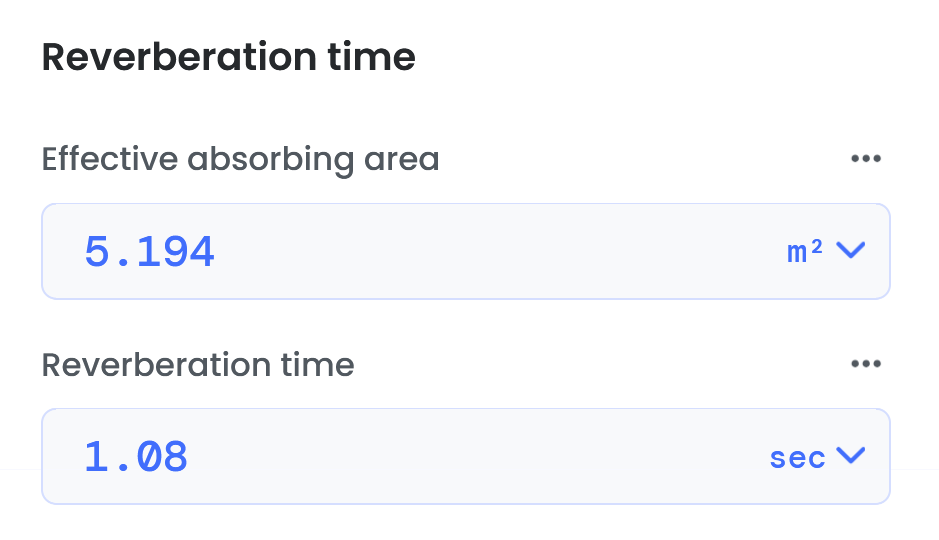
Guest Lecture: Social Implications of Acoustic Space and Sociopolitical Potentials of Spatialized Sound

I went to the mountains last weekend and did the exercise on my way back. I walked on this path at dusk and was surrounded by peaks and greenery and a few sheds. It was very calming and thus enjoyable, which is definitely due to the acoustics, but also due to the atmosphere and the general hightened mood from a good day. The few acoustic inputs that I noticed were a few [different kinds of] birds and a very light breeze. The other inputs were made by myself [gravel under my feet, steps, my clothing] or by my friends [talking and laughing]. All of these sounds were to be expected, but they did not feel intrusive.
4 Full Picture
For this last exercise, I wanted to take a deeper look at a room that I had already begun analyzing in the first exercise, namely Fusion on the ground level of HCI. As mentioned earlier in the blog, I have always felt like it had one of the worst acoustic profiles of any room on the campus.
The space is both used as a cafeteria and a working area. It is a space for people to eat, to have social interactions or to work. There is always a dense carpet of social noise from people talking, walking around, the rustling of clothing, items being placed on tables, chairs being moved around and also operational noise from people working in the cafeteria and from infrastructural systems. – What is required, however, is low background noise and good speech intelligibility. But instead of dulling unwanted noise, the room amplifies it. There is a lot of reverberation in the room; all the sounds are echoed and thus emphasized, creating a diffuse density of noise that is very unpleasant. It is very loud and therefore hardly convenient for chatting or studying.
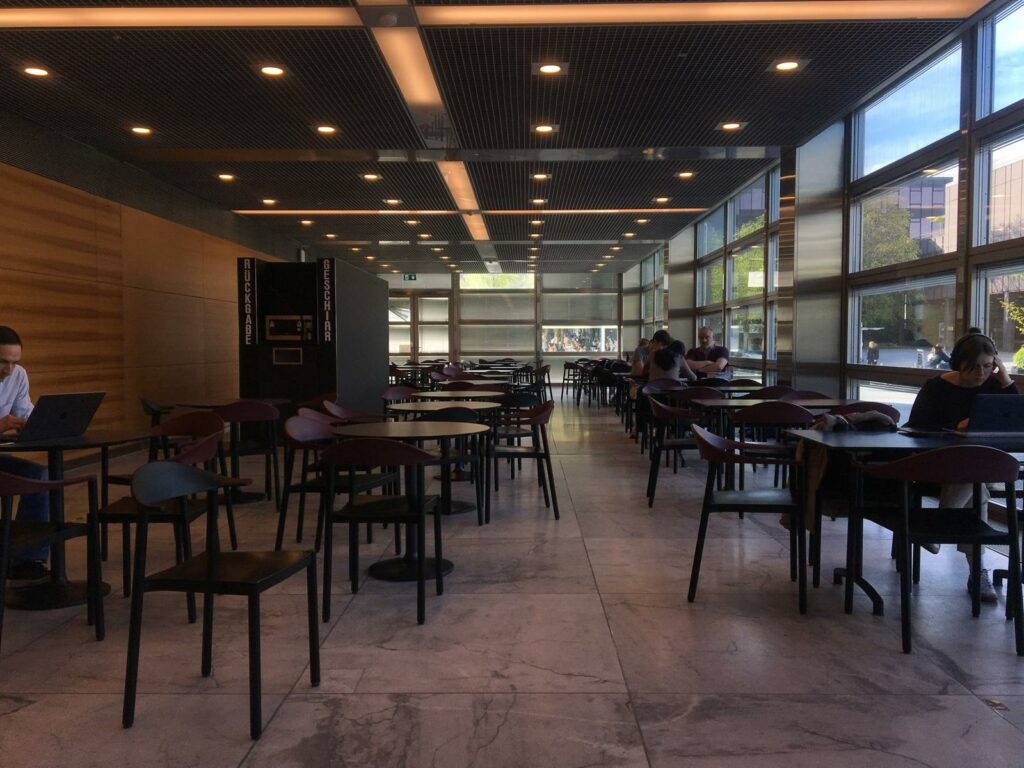
*While doing the recording, there were very few people in the room and I was not standing close to any of them. However, everything is clearly audible and it is definitely a lot more noisy and dense when there are more people.
The room is rectangular, measuring approximately 30 meters in length and 7.5 meters in width. It opens to the rest of the building through a recess formed by an indentation of about 2 meters on one of the short walls and about 6 meters on one of the long walls, which would meet at the corner. The recessed long wall is made from imitation wood and the other three walls from huge glass panels that reach from the floor all the way up to the ceiling, which is about 3 meters high. The visible part of it is made from metal grids that are covering the underlying infrastucture and the floor is made from stone tiles. The furnishing of the room is made up of tables and chairs, the latter of which have no kind of felt on the bottom to dull their noise.
All of the materials used in this room – stone, glass, metal and imitation wood – have very hard surfaces and are [highly] sound reflective. The ceiling functions [through its grid structure] kind of like a perforated ceiling – as in the sound is being diffused – but it is made from metal and there are no absorbers [visible]. The imitation wood might do a better job at absorbing and diffusing than the other surfaces, but clearly not a good enough one. Through the structural design of the building, there are pillars breaking up the huge glass panels, that might diffuse the sound a tiny bit. But overall, the room is very long with two parallel pairs of walls risking flutter echoes and reflective surfaces; which is acoustically just not ideal. The only absorptive element are the people in the room, but they are also the ones generating most of the noise.
Since the space has a mixed use as a cafeteria and a working space, there is no explicit definition of its criteria regarding acoustics. The following specifications, standards and guidelines that are [probably] applicable are approximations from other comparable rooms.
SECO (Swiss State Secretariat for Economic Affairs)
discusses noise limits in work environments
→ noise must primarily be reduced at its source to the lowest feasible level
SUVA
aims to prevent mental stress and promote communication comfort
disturbing noise at workplace
→ the recommended values cover all noise emissions affecting the workplace, with the exception of communication (such as conversations with other people, telephone ringing, acoustic signals, etc.)
office spaces: single offices, shared offices, open-plan offices
noise exposure level → Leq,1h ≤ 55-65 dB(A)
background noise at workplace
→ in this context, background noise refers to all sound emissions originating from built-in technical installations (e.g. building services such as ventilation systems, compressors, heating systems, background music) as well as noise emissions from outside sources (operational noise, traffic noise)
company cafeteria
noise exposure level → Leq,1h ≤ 55 dB(A)
*the noise outside is significantly less of a problem than the noise inside, since ouside there are just people talking, walking and buses driving by
*inside there is background noise, which intensifies the sound carpet
DIN 18041 [German standard]
reverberation time in rooms for individual communication
group b
→ similar rooms are to be treated correspondingly
→ in rooms with various kinds of uses, the higher recommendation of the A/V ratio [acoustic absorption area A to the room volume V] is to be consulted
recommended values for the A/V ratio
B3 refectory, cafeteria ≥ 0.20
B4 offices ≥ 0.25
B5 refectories and cafeterias in schools ≥ 0.30
target reverberation time (RT60) in an empty room → 0.5–1.0 seconds
Calculations
room measurements 7.5m (width) x 30m (length) x 3m (height)
room volume → 7.5m x 30m x 3m = 675m³
wood imitation wall → (30m – 6m) x 3m = 72m²
glass walls → (7.5m – 2m) x 3 + 30m x 3m + 7.5m x 3m = 192m²
stone tile floor → 30m x 7.5m = 225m²
metal grid ceiling → 30m x 7.5m = 225m²
absorption coefficients α:
| imitation wood (laminate) | 0.05 – 0.15 |
| glass | 0.02 – 0.05 |
| stone tiles (marble) | 0.01 – 0.03 |
| metal grids (perforated) | 0.05 – 0.50 |
current reverberation time – calculated with Sabine Equation:

∑ = 72m² x 0.05 + 192m² x 0.02 + 225m² x 0.01 + 225m² x 0.05 = 20.94m²

→ quite long reverberation time
targeted reverberation time:
RT(60) = 0.5-1.0 seconds
equivalent absorption area for [max] reverberation time of 1.0 second:

→ min absorption area necessary
equivalent absorption area for reverberation time of 0.5 seconds:

→ targeted absorption area A = 108.675m² – 217.35m²
targeted absorption area – calculated with A/V ratio:


current absorption area A = ∑ = 20.94m²
To get from the current absorption area to the targeted absorption area and targeted reverberation time, a lot more absorbing materials need to be added to the space. In order to keep the pristine glass windows and the hygienic floor, reasonable areas to put absorptive measures would [in my opinion] be the ceiling and wood imitation wall, leaving us with a physical surface area S = 297m². Since the [targeted] absorption area is A = S ⋅ α, the physical surface needed to reach the target is dependant on the kind of absorber with its materiality and according absorption coefficient. Basic acoustic panels with α = 0.5 would result in a much bigger physical area than high performing acoustic panels with α = 0.9.
min absorption area → A = 108.675m²
wood imitation wall → S = 72m²
metal grid ceiling → S = 225m²
absorption coefficient necessary when only using ceiling surface
→ α = A/S = 108.675m²/225m² = 0.483
It would – in theory – be possible to reach the targets by just putting basic acoustic panels on the ceiling. However, the room is quite long and there are flutter echoes to be dealt with. Therefore, it makes sense to also treat the wood imitation wall acoustically. Also, the calculation was done for the minimal necessary absorption coefficient; and it makes sense to do more than the minimum for the acoustic treatment of the room.
I think it would make sense to treat the ceiling with absorptive panels of
α = 0.5 and the wood imitation wall with absorptive panels of α = 0.3-0.4 to reach an absorptive area of 134.1-141.5m², which is close to the area calculated with the A/V ratio. But in order to make the wall align better with the rest of the sleek and sterile design of the room and building, it might make sense to use either a textured wall that looks 3d printed while still absorbing and diffusing sounds, or, when sticking more closely to the initial look, to use slender wooden panels with gaps for absorptive material in between.
Generally speaking, one could also use curtains, furniture and plants to absorb and diffuse sounds, but I feel like they would be at odds with the current vision of the room. However, I personally think they would create a much more cozy and welcoming atmosphere, creating a space that would actually be nice to study or eat in.
5 Final Assignment
The room is rectangular with a door in one of the long walls leading to a corridor outside and a window on the left side of it [if looked at from inside the room]. Both this wall and the shorter wall next to the window are made of painted brick, whereas the other two walls are plastered and painted. Both the floor and the ceiling are made of painted concrete and there are 8 protruding lights on ceiling, that are spaced out evenly through the center of the room. There are also 10 parallel metal pipes above and to the right side of the door [about 2/3 of the room length] and 3 ventilation pipes on the other.

room measurements → 7.5m (width) x 30m (length) x 3m (height)
room volume → 7.8m x 12m x 3m = 280.8m³
short walls [each] → 7.8m x 3m = 23.4m²
long walls [each] → 12m x 3m = 36m²
floor and ceiling [each] → 7.8m x 12m = 93.6m²
window → 3m x 0.5 m = 1.5m²
door → 1.2m x 2m = 2.4m²
cardboard → 1m x 1.5m x 6 = 9m²
lights → 1.2m x 1.2m x 8 = 11.52m²
There is are three metal racks; two lower ones on either side of the door and one that reaches up to the ceiling on the short plaster wall. They are used to store things and to put the models. 6 cardboard rectangles are placed next to each other on the long plastered wall to pin up stuff and there are two horizontal pipes right below it. There are 8 movable tables made of metal and pressed wood, and two smaller ones made entirely of pressed wood. Lastly, there is a canvas on the short brick wall and there are a bunch of plastic and wooden chairs scattered across the room.
The room is very live and loud, even with little noise input. This is due to all the hard and reflective surfaces and the lack of absorbtive materials. The room is a brick-concrete box with flat parallel walls that reflect the sound, and there is only little diffusion of the sound inputs through the spaced out pipes, lights, tables, chairs, equipment and models. This might seem like a lot, but due to those things also being made of reflective materials (except for the models), the room becomes even more live. Due to the moderate size of the room, the reverberation time is not too bad and speech is intelligible, which is aided by the reasonable distance between the speaker and the listener.
*When recording, I was the only person in the room and I created some noise on purpose. All I did was roll around in my chair, cough and move around some paper.
Legal Standards
SUVA
Industry and commerce, Group 2: Activities with temporarily or consistently high demands for concentration, such as monitoring tasks in the context of production as well as quality control.
noise exposure level → LEX,8h < 65 dB(A)
DIN 18041
Reverberation time – rooms for speech communication
A3 type of usage: “teaching/communication” (up to 1000m³) as well as “speech/lecture included” (up to 5000m³)

SIA 181 – sound insulation
High noise exposure, but low noise sensitivity → 52dB
*not very relevant in this case since it is an enclosed space underground
Calculations
current reverberation time:

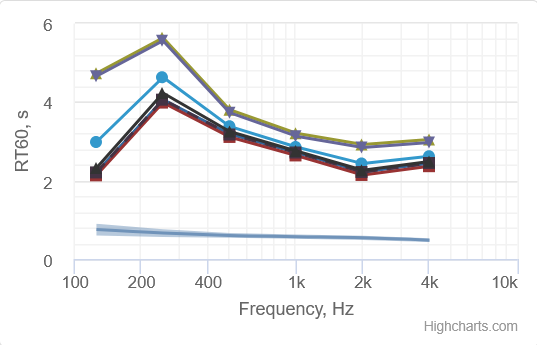
The RT60 calculator is, like the balloon method, an approximation of the acutal reverberation time. Since the calculation is done with just walls, ceiling and floor and the respective materials [and no furnishings are accounted for], the indicated RT is much longer than in the balloon test.
targeted reverberation time:

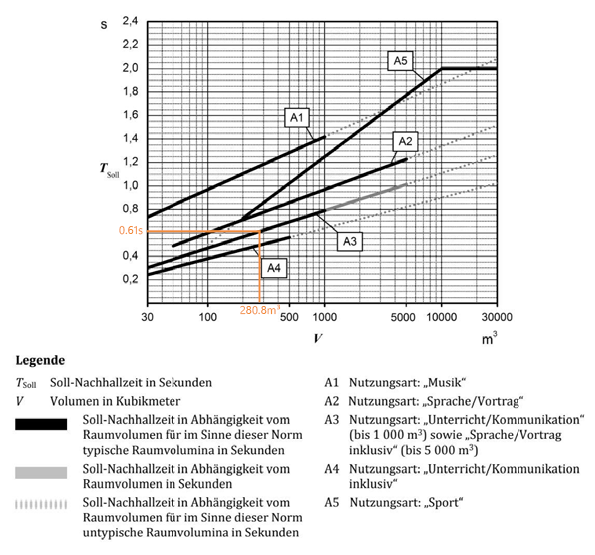
room volume →
7.8m x 12m x 3m = 280.8m³
log10(280.8) ≈ 2.448
TSoll, A3 = 0.32 x 2.448 – 0.17
= 0.7843 – 0.17 = 0.6134s
equivalent absorption area – calculated with Sabine Equation:

current absorption area – calculated with Sabine Equation:

Acoustic Treatment
| concrete | 0.05-0.08 → avg. 0.065 |
| plaster | 0.01-0.05 → avg. 0.03 |
| cardboard | 0.10-0.50 → avg. 0.30 |
To get from the current absorption area to the targeted absorption area and targeted reverberation time, a lot more absorbing materials need to be added to the space. There are several reasonable areas to put absorptive measures, but I think some are more suited than others. The room can get very dirty, needs to be somewhat reconfigurable and there is a lot of tear on the floor for example, making it not the ideal to place absorbers. [If it were rubber flooring for example, it could be cleaned easily and reduce the noise input, but the absorption coefficient of it is not very high.] Since treatment of the entire wall is not possible through the metal pipes, but also not necessary, I would substitute the pin walls through felt [which can still serve same purpose] and put two more, in order to absorb a lot of first reflections from that long wall and the reflections of the opposite wall to avoid flutter echoes. The felt is of medium thickness [3cm], since the main target are mid to high frequencies. I would also put absorbtive panels on the ceiling and plastered wall to absorb more of the reflections [especially the ones on the back] and increase speech clarity. This also keeps the shelf and its purpose intact, meaning it can still be used to store, but also display the models. [I initially thought of putting a curtain in front, but abandoned the idea due to the dirt/ dust created by the workshop.]
substitute cardboard with felt [3cm] and put two more panels → α = 0.8
41.09m² – (9m² x 0.3) – (3m² x 0.3) + (12m² x 0.8) = 47.96m²
space out acoustic tiles on the ceiling center → α = 0.75
put acoustic tiles on short wall with metal rack → α = 0.75
47.96m² – (20m² x 0.065 + 23.4m² x 0.03) + (20m² x 0.75 + 23.4m² x 0.75) ≈ 78 m²
→ A bit more than targeted absorption area, but can’t hurt to lower reverberation time a bit more. This way, communication and the work climate are going to be more pleasant.
*subtracted areas given up, added replacements
